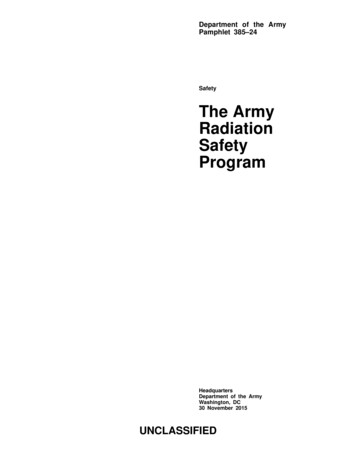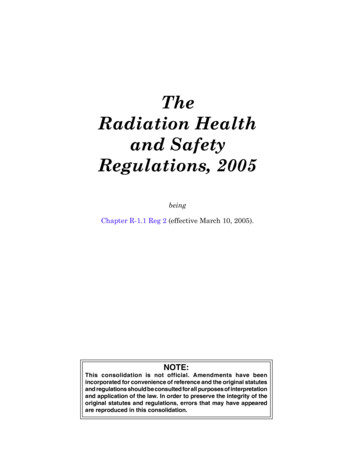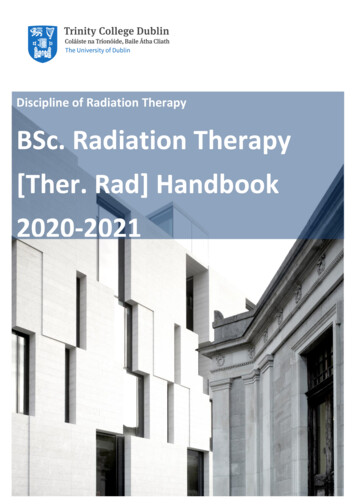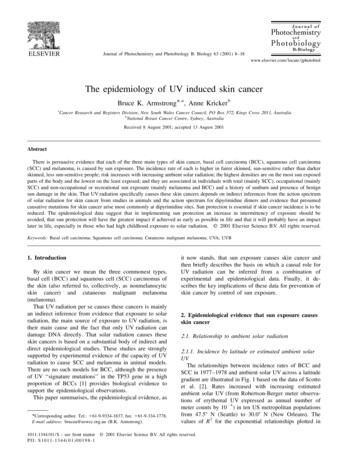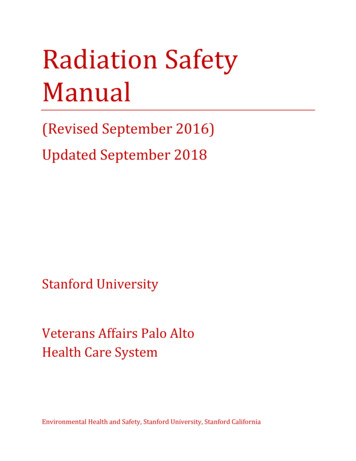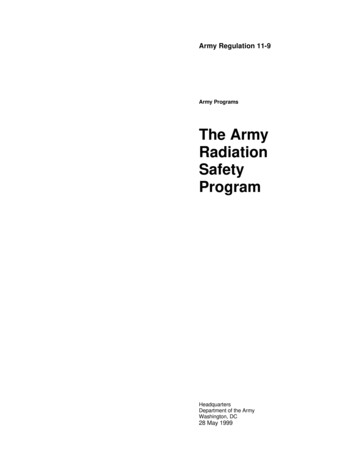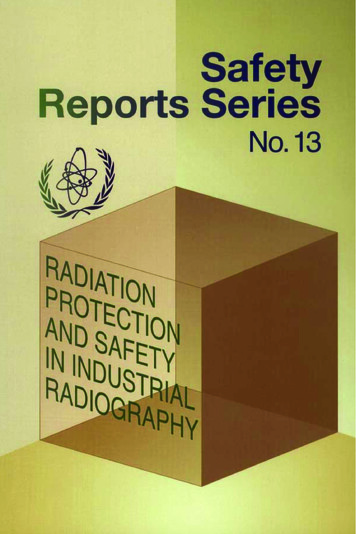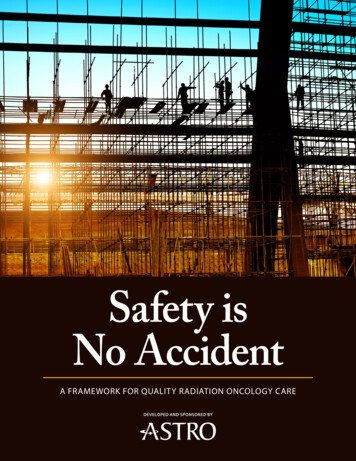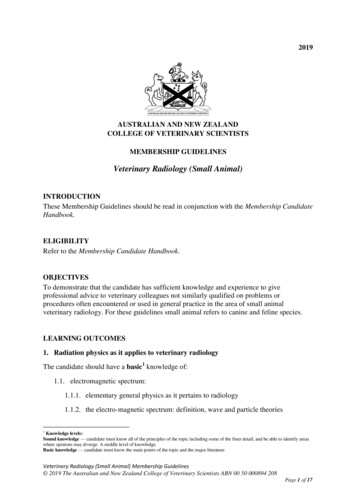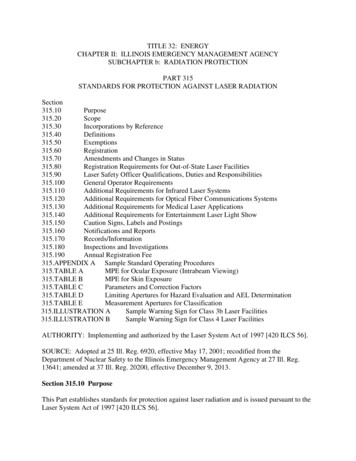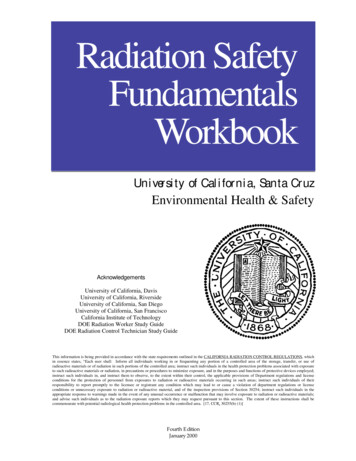
Transcription
Radiation SafetyFundamentalsWorkbookUniversity of California, Santa CruzEnvironmental Health & SafetyAcknowledgementsUniversity of California, DavisUniversity of California, RiversideUniversity of California, San DiegoUniversity of California, San FranciscoCalifornia Institute of TechnologyDOE Radiation Worker Study GuideDOE Radiation Control Technician Study GuideThis information is being provided in accordance with the state requirements outlined in the CALIFORNIA RADIATION CONTROL REGULATIONS, whichin essence states, “Each user shall: Inform all individuals working in or frequenting any portion of a controlled area of the storage, transfer, or use ofradioactive materials or of radiation in such portions of the controlled area; instruct such individuals in the health protection problems associated with exposureto such radioactive materials or radiation, in precautions or procedures to minimize exposure, and in the purposes and functions of protective devices employed;instruct such individuals in, and instruct them to observe, to the extent within their control, the applicable provisions of Department regulations and licenseconditions for the protection of personnel from exposures to radiation or radioactive materials occurring in such areas; instruct such individuals of theirresponsibility to report promptly to the licensee or registrant any condition which may lead to or cause a violation of department regulations or licenseconditions or unnecessary exposure to radiation or radioactive material, and of the inspection provisions of Section 30254; instruct such individuals in theappropriate response to warnings made in the event of any unusual occurrence or malfunction that may involve exposure to radiation or radioactive materials;and advise such individuals as to the radiation exposure reports which they may request pursuant to this section. The extent of these instructions shall becommensurate with potential radiological health protection problems in the controlled area. [17, CCR, 30255(b) (1)]Fourth EditionJanuary 2000
Radiation Safety Fundamentals WorkbookTable of Contents1 Introduction . 12 Objectives. 22.1Radiation Safety Fundamentals. 22.2On-the-Job Training. 32.3Specialized Training . 32.4Annual Refresher Training. 33 Ionizing Radiation. 43.1Atomic structure. 43.2Atomic Number . 53.3Radioactivity . 53.4Ionizing and Non-ionizing Radiation. 64 Units of Measurement . 84.1Activity . 84.2Exposure . 84.3Absorbed Dose. 94.4Quality Factor . 94.5Dose Equivalent . 95 Radioactive Decay . 125.1The Nature of Radioactivity. 125.2Alpha Particles . 125.3Beta Particles . 135.4Gamma Rays / X-rays . 155.5Neutron Particles. 165.6Radioactive Half-life. 186 Sources of Radiation. 206.1Natural Sources. 206.2Human-made Sources . 216.3Comparison of Radiation Doses. 217 Biological Effects. 237.1Effects of Radiation on Cells . 237.2Acute and Chronic Radiation Dose. 257.3DNA Effects. 277.4Prenatal Radiation Exposure . 277.5Dose Response Curves. 288 Occupational Radiation Exposure Risks . 318.1Risk from Exposures to Ionizing Radiation . 318.2Comparison of Occupational Radiation Exposure Risk and Other Risks . 328.3Benefit versus Risk . 339 Dose Limits . 349.1Dose Philosophy . 349.2Radiation Worker Dose Limits . 349.3Declared Pregnant Worker (Embryo/Fetus) Dose Limits . 359.4General Public Dose Limits . 3610 As Low as Reasonably Achievable (ALARA). 3810.1 Why ALARA? . 3810.2 Responsibilities for the ALARA Program . 3810.3 Personnel Responsibilities for the ALARA Program. 3910.4 Principles of Radiation Protections . 4011 Internal Radiation Protection . 4111.1 Contamination Control. 4111.2 Personal Protective Equipment (PPE). 4311.3 Food and Drink Policy . 4312 External Radiation Protection . 4512.1 Time . 4512.2 Distance . 46
12.3 Shielding . 4613 Radiation Use Permits .4913.1 Radiation Safety Office. 4913.2 Radiation Use Authorizations (RUAs). 4913.3 Your Responsibilities . 5014 Radiological Identification System.5214.1 Radioactive Materials Use Area. 5214.2 Radiation Area . 5315 Radiation Survey Meters .5515.1 Geiger-Mueller Detector . 5515.2 NaI Scintillation Detector . 5515.3 Ion Chamber. 5615.4 Calibration. 5615.5 Efficiency . 5616 Dosimetry.5716.1 Types of Dosimetry Used on Campus. 5716.2 Precautions on Use of Dosimetry. 5716.3 Internal Monitoring . 5816.4 Dosimetry Records. 5816.5 State Notification . 5917 Emergency Procedures .6017.1 Personnel Contamination and Exposure. 6017.2 Large Radioactive Spills ( 0.1 mCi 125I, 1 mCi of other radionuclides). 6117.3 Small Radioactive Spills ( 0.1 mCi 125I, 1 mCi of other radionuclides). 6118 Summary .63
Radiation Safety Fundamentals Workbook1IntroductionHere at UCSC, you may in the course of your education or employment work withradioactive isotopes or radiation producing machines. We use radioactivity in experimentaland diagnostic situations at UCSC because there is no better way to obtain the informationwe seek. However, working with radioactivity has unavoidable risks. Compared with otherenvironmental hazards in the laboratory, we know a great deal about these risks and, unlikeother hazardous material, radiation is relatively easy to measure and protect ourselvesagainst.One of the means by which the safe use and handling of radioactive isotopes or radiationproducing machines may be accomplished is for you to become familiar with some of thetechnical and practical aspects associated with the safe use of the more common sources ofradiation found at UCSC.The goal of this handbook is to provide sufficient information so that you will be able toidentify and deal effectively with the radiation hazards in the immediate work area, thusproviding for your own safety, the safety of those around you, and the protection of theenvironment. State and University requirements will also be outlined.If you would like to review some of the key information presented in this manual, you canaccess our on-line Web-based tutorial at www.ehs.ucsc.edu . However, this tutorial does notpresent all the information included in this manual. Please use it for review and/orclarification of this manual, rather than as a replacement.UCSC is licensed to possess various amounts of radioactive material and radiationproducing machines that may be used in a variety of procedures. A broad scope licenseconfers authority upon the University to approve, manage, and control the receipt, use, anddisposal of radioactive materials and radiation producing machines. In fact, the Universitymust act to “police” itself under the authority given in its broad scope license.As you review this guide, please keep in mind that each worker at UCSC must beresponsible for his or her own safety. Knowledge of the following guidelines andprocedures will help to ensure that you can continue to conduct your research safely andwithout incident. Here at UCSC, as at other educational institutions, working withradioactive material is a privilege, not a right. A serious violation or accident could result inthe cancellation of the State Radioactive Materials License for the whole University.Therefore, the Radiation Safety Committee and the EH&S Radiation Safety Department takeviolations of UCSC policies regarding radiation safety very seriously.Radiation Safety staff are available for your consultation on the safe use of radioactivematerials and radiation producing machines. Feel free to call us at extension x9-2553 withany questions.January 20001
University of California, Santa Cruz2ObjectivesThis manual is a companion to the Radiation Safety Manual (RSM). The RSM describes theradiation protection program at UCSC. The policies and procedures contained in the RSMhave been approved by the Radiation Safety Committee (RSC), and are submitted to theCalifornia Department of Health Services as part of our radioactive materials license.2.1Radiation Safety FundamentalsThis Radiation Safety Fundamentals Workbook presents the information necessaryfor users of radioactive materials and radiation producing machines to properlyunderstand and follow the procedures in the RSM.After studying this workbook you will need to pass a written examinationadministered by EH&S Radiation Safety Department. To use radioactive material atUCSC, you must first obtain authorization from the EH&S Radiation SafetyDepartment.All new radiation users will need to complete the following:2 Read this Radiation Safety Fundamentals Workbook. You will be responsiblefor knowing all the information in this document. A closed book test will beadministered and must be passed before radiation work begins. The questionswill be similar to those included in this workbook. In order to become an approved radiation user you will be required to haveseveral important documents on file with the Radiation Safety Office. You willneed to complete a Training and Experience Form to provide information aboutyou and your radiation use experience. Your Principal Investigator must signthis form to add your name to their permit, indicating that they will beresponsible for your supervision. If you have previously worked withradioactive materials or radiation producing equipment, complete the ExposureHistory Request Form for the last institution where you were a radiation worker.If you are female, read through the Prenatal Packet carefully. Sign and returnForm 1 Prenatal Radiation Exposure Risks and Precautions indicating that youhave received information on UCSC’s prenatal radiation exposure policy. Ifyou are now pregnant or attempting to become pregnant and want to declareyourself pregnant, complete Form 2 Notification of Status as a DeclaredPregnant Woman. Call the EH&S Radiation Safety office (x9-2553) to schedule a time to watch athirty minute video and to take the written exam. This may be scheduled at yourconvenience (Monday through Friday, 8 a.m. - 4 p.m.) Please bring thedocuments described above when you come in to take your test. If you successfully pass the exam you will be issued dosimetry (if needed) andauthorized to begin working with radiation under the supervision of a moreexperienced user in the lab. You will be required to attend a specialized trainingclass offered by Radiation Safety within four months of receiving initialauthorization.EH&S
Radiation Safety Fundamentals Workbook2.2On-the-Job TrainingThis written guide does not replace the requirement that a laboratory supervisor oran appropriate alternate provide practical, hands-on training in the correct storage,use, disposal, and transportation of radioactive materials.After receiving authorization by EH&S Radiation Safety you may begin usingradioisotopes under the supervision of the Principal Investigator (PI) or theappropriate alternate. Hands-on training for each user is also provided in thelaboratory by the Principal Investigator or an experienced user designated by the PI.Topics covered during this training include, as appropriate: Safe use of laboratory equipment and materials, including protective clothing. Experiment procedures and protocols, including operating procedures forradiation producing machines. Safe handling, storage, and disposal of radioactive materials. Methods to control and measure radiation levels and contamination. Proper maintenance of required records. Emergency procedures.2.3Specialized TrainingWithin 4 months of passing the Radiation Safety Fundamentals test you will berequired to attend a four-hour training class on one or more of the following topicsdepending on the type of work your laboratory performs: Radioisotope Laboratory Safety Sealed Source Safety X-ray Producing Machine SafetyClass dates and locations are posted on the EH&S website www.ehs.ucsc.edu .After completing this class and with the concurrence of the PI you will be able towork as an independent radiation user.2.4Annual Refresher TrainingYou will also be required to attend annual refresher training, usually presented at ameeting of each research group, to keep up-to-date with the latest regulations anduniversity policies. EH&S Radiation Safety will assist you in meeting thisrequirement.January 20003
University of California, Santa Cruz3Ionizing RadiationTo understand radiation safety procedures, some knowledge of the physical properties ofionizing radiation is required. A basic understanding of chemistry and physics is assumed.3.1Atomic structureThe basic unit of matter is the atom. The basic atomic model, as described byErnest Rutherford and Neils Bohr in 1911, consists of a positively charged coresurrounded by negatively-charge shells. The central core, called the nucleus,contains protons and neutrons. Nuclear forces hold the nucleus together. The shellsare formed by electrons which exist in structured orbits around the nucleus.What are thethree basic partsof an atom?ProtonsProtons (p ) are positively charged and locatedin the nucleus of the atom. The number ofprotons determines the element.NeutronsNeutrons (n) are uncharged and located in thenucleus of the atom. Atoms of the sameelement have the same number of protons, butcan have a different number of neutrons.Atoms which have the same number of protonsbut different numbers of neutrons are calledisotopes. Isotopes have the same chemicalproperties; however, the nuclear properties canbe quite different.Figure 1 Atomic ModelElectronsElectrons (e-) are negatively charged and travel in specific orbits or energylevels about the nucleus. Each electron has energy which enables it to resist thepositive charge of the nucleus. An atom is electrically neutral if the totalelectron charge equals the total proton charge. Electrons are bound to thepositively charged nucleus by electrostatic attraction.The number of electrons and protons determines the overall electrical charge of theatom. The term ion is used to define atoms or groups of atoms that have a netpositive or negative electrical charge.The energy of ionizing radiation is usually given in electron volts (eV). Theelectron volt is defined as the energy of an electron that has been acceleratedthrough an electron potential of one volt. The eV is a very small amount of energyand therefore keV (thousand electron volts) and MeV (million electron volts) areused as the units of measurement for the energies associated with the emission forradioactive materials or machines. The energy of visible light is about two or threeeV.4EH&S
Radiation Safety Fundamentals Workbook3.2Atomic NumberThe number of protons in the nucleus of an element is called the atomic number (Z).Atomic numbers are all integers. For example a hydrogen atom has one proton inthe nucleus. Therefore, the atomic number of hydrogen is 1. A helium atom hastwo protons in the nucleus, which means the atomic number is 2. Uranium hasninety-two protons in the nucleus and, therefore, has an atomic number of 92.Elements with atomic numbers greater than 92 can be produced in the laboratory.The organization of elements into groups with similar chemical properties in theperiodic table is based on atomic numbers.The mass number is the sum of the protons and neutrons in an atom. Although allatoms of an element have the same number of protons, they may have a differentnumber of neutrons. Atoms that have the same number of protons but differentnumbers of neutrons are called isotopes. For example, deuterium (2H) and tritium(3H) are isotopes of hydrogen with mass numbers of two and three respectively.e-e-epnnpp n1Hhydrogen veFigure 2 Isotopes of HydrogenNote: Nuclide notationThe mass number can be used with the name of the element to identify whichisotope of an element we are referring to. If we are referring to the isotope ofphosphorous that has a mass number of 32, we can write it as phosporous-32.If we are referring to the isotope of mass number 33, we write it asphosporous-33.Often, this expression is shortened by using the chemical symbol instead of thefull name of the element, as in P-32 or P-33. Alternatively, the nuclide can bespecified by using the chemical symbol, with the mass number written as asuperscript at the upper left of the symbol:AXWhere: X Symbol for elementA Mass number (number of protons (Z) plus the number of neutrons (N))For example, the notation for uranium-238 would be 238U.3.3RadioactivityOnly certain combinations of neutrons and protons result in stable atoms. If thereare too many or too few neutrons for a given number of protons, the resultingnucleus will have excess energy. The unstable atom will become stable by releasingexcess energy in the form of particles or energy (quanta). This emission of particlesJanuary 20005
University of California, Santa Cruzor energy from the nucleus is called radiation. These unstable atoms are also knownas radioactive material.The property of certain nuclides to spontaneously emit radiation is calledradioactivity. (The term radionuclide has been coined to refer to these radioactivenuclides.) There are on the order of 200 stable nuclides and over 1100 unstable(radioactive) nuclides.The emission of a particle or energy (electromagnetic radiation) in order to reach amore stable configuration usually results in the formation of a new element.Following this transmutation the nucleus is usually more stable. As the energy ofthe nucleus is reduced, the nucleus is said to disintegrate. The process by which anucleus spontaneously disintegrates (or is transformed) is called radioactive decay.3.4Ionizing and Non-ionizing atories falls into twobroad categories depending onits ability to form adiation that has singleparticles or quanta withenough energy to ejectelectrons from atoms, isknown as ionizing radiation.From the standpoint of humanhealth and safety, ionizingFigure 3 Ionizationradiation is of greater concernsince it can create many energetic ionized atoms which in living cells engage inchemical reactions that interfere with the normal processes of cells.Energy (particles or rays) emitted from radioactive atoms can cause ionization.Ionizing radiation includes alpha particles, beta particles, gamma or x-rays, andneutron particles.Non-ionizing radiation does not have enough energy to eject electrons fromelectrically neutral atoms Examples of non-ionizing radiation are ultraviolet (couldionize), visible light, infrared, microwaves, radio waves, and heat.6EH&S
Radiation Safety Fundamentals WorkbookStudy Questions:1. The basic parts of an atom are , , and.2. The process of orbital electrons from neutral atoms is called .3. Radioactive material contains atoms.4. A certain isotope of carbon has a Z number of 6 and a mass number ( A ) of 11. Howmany neutrons are present in the nucleus of this isotope?A) sixB) elevenC) fiveD) seventeen5. radiation doesn't have enough energy to an atom.January 20007
University of California, Santa Cruz4Units of MeasurementIn measurements of ionizing radiation, different units are used to quantify: The activity of radioisotopes in disintegrations per unit time;Exposure (roentgen);Absorbed dose (rad); andAbsorbed dose of various types of radiation relative to x-rays (rem).These units are commonly used in UCSC laboratories. For example, the contents ofradioactive vials are described in microcuries, exposure meters that measure radioactiveexposure read in milliroentgens/hour, and the results of film badges are recorded inmillirems.4.1Activity is therate of decay(disintegrationsper time) of agiven amount ofradioactivematerial.ActivityThe quantity of activity of a radioisotope isexpressed in terms of the number ofdisintegrations the nucleus undergoes per unittime. Since the fundamental unit of time is thesecond, the quantity of activity is measured indisintegration per second (dps). Because thesecond is a very short time period in which tomake a measurement, activity is usuallymeasured in units of disintegrations per minutes(dpm).The historical unit of activity is the curie. Thecurie is a very large unit of activity and is definedas 3.7x1010 disintegrations per second. Mostradioactive samples at UCSC contain amounts ofactivity which are more approximately measuredin millicuries (mCi or 1x10-3 curies) ormicrocuries (µCi or 1x10-6 curies).Figure 4 The curie is namedafter Pierre Curiephotographed above with hiswife Marie Curie.The SI unit of activity is the becquerel. The becquerel is a very small unit ofactivity and is defined as 1 disintegration per second. More appropriate units forexpressing the activity of a sample in becquerels are megabecquerels (MBq or 1x106becquerels) and gigabecquerels (GBq or 1x109 becquerels).4.2Exposure is ameasure of theionizationproduced in airby x-ray orgamma.8ExposureExposure is a measure of the ability of photons (x and gamma) to produce ionizationin air. Traditionally, the unit of exposure is the roentgen (R). The unit is defined asthe sum of charge per unit mass of air that is:1 Roentgen 2.58x10-4 coulombs/kg of airThere is no SI unit defined for exposure. This was done to discourage further use ofthe quantity.EH&S
Radiation Safety Fundamentals Workbook4.3Absorbed DoseUnits of dose quantify the amount of energy absorbed or deposited per
Here at UCSC, you may in the course of your education or employment work with radioactive isotopes or radiation producing machines. We use radioactivity in experimental and diagnostic situations at UCSC because there is no better way to obtain the information we seek. However, working with radioactivity has unavoidable risks. Compared with other
